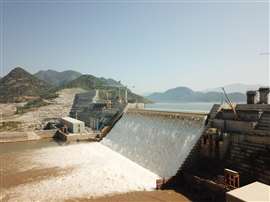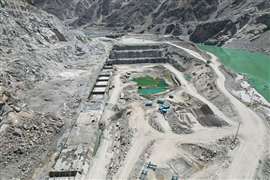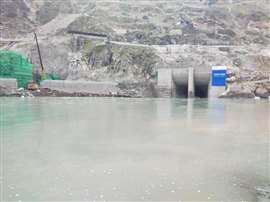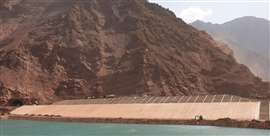5 of the world’s biggest hydroelectric dam projects under construction
22 August 2023
As countries around the world work to produce more clean energy to meet their carbon emissions targets, hydroelectric power construction projects are becoming increasingly popular.
China has announced a target of 120 GW of pumped storage hydropower capacity by 2030.
Meanwhile, the Indian government has set out plans to achieve 18.8 GW of pumped storage by 2032 and the US is also expected to invest more into hydropower projects as part of its Inflation Reduction Act.
The International Hydropower Association’s (IHA) annual report 2022-23 put the annual average of new hydropower capacity for the last five years at 22 GW. But it noted that this is well short of the 45 GW per year that is needed to reach net zero emissions by 2050.
Nonetheless, there are some major hydroelectric power projects already underway, with several driven by China’s Belt and Road Initiative (BRI). International Construction examines five of the biggest:
1) Grand Ethiopian Renaissance Dam (GERD), Ethiopia
 Grand Ethiopian Renaissance Dam (Image: Webuild)
Grand Ethiopian Renaissance Dam (Image: Webuild)
Italian contractor Webuild is constructing the GERD, with work starting more than a decade ago in 2011. The US$5 billion project is now more than 90% complete.
The Ethiopian government expects the dam to generate up to 6,500MW of electricity, which would double the country’s annual national electricity output.
The dam, 700km northwest of the capital Addis Ababa, will be the biggest hydropower dam in Africa. The main roller compacted concrete (RCC) dam will be 1,800 metres long and 170 metres high. The project also includes a rockfill saddle dam and two power stations installed downstream at the foot of the dam on opposite shores.
It will create a reservoir covering 1,875 sq km and contain 74 billion cubic metres of water.
The plant will have an installed production capacity of 5,150 MW, with 10,000 people working on its construction on a yearly average.
The project has not been without controversy, with Egypt and Sudan, which neighbour Ethiopia downstream, expressing concern that the dam could lead to a reduced water flow in the Nile River.
Although more recently, Sudan appears to have changed its view, hoping that the dam will be able to help limit annual flooding in the country.
2) Diamer-Bhasha Dam, Pakistan
 Work on the Diamer Bhasha dam is underway (Image: Pakistan Water and Power Development Authority [WAPDA])
Work on the Diamer Bhasha dam is underway (Image: Pakistan Water and Power Development Authority [WAPDA])
The Diamer-Bhasha dam in Pakistan will be the tallest RCC dam in the world when complete, at 272 metres tall.
It will sit on the River Indus between Kohistan district in Khyber Pakhtunkhwa and the Diamer district in Gilgit Baltistan, with the capacity to store 10.5 cubic kilometres of water.
A joint venture between one of China’s largest state-owned electricity producers, China Power Investment Corporation, and Pakistan’s military engineering organization, the Frontier Works Organisation (FWO) signed a deal to build the dam in 2020.
The dam’s construction is expected to cost around US$5 billion, with another $7 billion required for the power generation.
The power station will consist of two underground power houses on each side of the main dam and a total of six turbines, with a total installed capacity of 4,500MW.
Construction work is expected to be completed in 2029 but the project has taken a long time to reach this stage, having first been conceived in 1998. International lenders such as the World Bank, Asian Development Bank and International Monetary Fund were unwilling to invest because the dam is in territory disputed by Pakistan and India.
However, a recent bond issued by the government of Pakistan’s former prime minister Imran Khan in 2021 raised $500 million in capital for the project from investors.
3) Dasu hydropower project, Pakistan
 A diversion tunnel for the Dasu hydropower project (Image: WAPDA)
A diversion tunnel for the Dasu hydropower project (Image: WAPDA)
Pakistan is also building the first stage of the Dasu hydropower project on the Indus River, 7km north of the town of Dasu in the district of Kohistan in Khyber Pakhtunkhwa province.
The two-stage project, being built under China’s Belt and Road Initiative (BRI), involves diverting the river downstream of the Diamer-Bhasha dam through two diversion tunnels.
The first of the two tunnels, Tunnel B, is complete, with the Indus now flowing through it instead of along its natural course. The 1.33km-long diversion is 20m wide and 23m high. Tunnel A, which is 1.5km long and also 20m wide and 23m high is also nearing completion.
The completion of those tunnels has paved the way for the construction of a starter dam, ahead of the construction of a 242-metre-high RCC main dam.
China Gezhouba Group Company (CGGC) is main works contractor on the first stage of the project, which is expected to generate 2,160MW when complete.
The amount of power the project generates could be extended to 4,320MW in a second stage.
4) Rogun Dam, Tajikistan
 Rogun Dam, Tajikistan (Image: Webuild)
Rogun Dam, Tajikistan (Image: Webuild)
The Rogun Dam was a long-stalled project, construction of which started in the Soviet era in 1976 before being abandoned in 1993.
But it has since been revived by the Tajik government and work is currently underway.
Italian contractor Webuild is building the clay core rockfill dam, which will reportedly be the tallest in the world at 335 metres, with a crest length of 800m. Webuild reported in August that work on the dam is now around 30% complete.
Sitting on the Vakhsh river the dam’s power station will have six turbines of 600 MW each, with a total installed capacity of 3,600 MW.
In a deal between Webuild and the state-run Rogun Hydropower Project company, work is split into four lots. The first lots see the diversion of the Vakhsh River via two diversion tunnels in a mountainside to keep the foundations of the dam dry.
Once the dam is complete, it is expected to double energy production in the country.
5) Mambilla Hydropower Project, Nigeria
The Mambilla hydropower project on Dongo River near Kakara Village of Taraba State in Nigeria involves the construction of four dams and two underground powerhouses, with a total installed capacity of 3,050 MW.
A joint venture between China Gezhouba Group (CGGC), Sinohydro and CGCOC is building the project. The four dams are called Nya, Sumsum, Nghu and Api Weir. Nya and Sumsum will be 100m and 35m tall RCC dams while Nghu will be a 95m-high rockfill dam and Api Weir will be a small regulatory dam to raise the water level.
The two underground powerhouses will contain a total of 12 turbine generators.
The China Export Import (Exim) bank is financing 85% of the total estimated cost of $5.8 billion. The government of Nigeria is contributing about $870 million of the construction cost.
Work has been held up by landslides in the area as well as legal challenges. It is expected to be complete in 2030.
STAY CONNECTED



Receive the information you need when you need it through our world-leading magazines, newsletters and daily briefings.
CONNECT WITH THE TEAM








